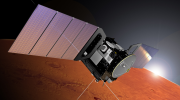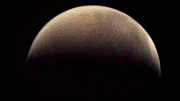As spacecraft operations engineers we’re used to operating without being able to see what we’re doing – we rely on the telemetry data from the spacecraft: numbers, statuses, bits and bytes to find out what’s happening. However, with something as big and complex as supporting an incoming lander it helps to see what’s going on, like this great Celestia simulation of Mars Express as it turns and tracks Curiosity down to the surface of Mars:
To learn more about this video, and what it shows, click ‘Continue’ to read on…
Here we can sit just behind Mars Express, looking “over the shoulder” of the spacecraft towards the approaching lander (marked by the red indicators). First we are in the dark, in the shadow of Mars, with Curiosity approaching in the sunlight on the far side. As the video starts, Mars Express is turning to point its Melacom antenna towards Curiosity. Once pointed properly, thanks to our Flight Dynamics team, the antenna boresight tracks the lander as it makes its final approach. Flying out into the sunlight from behind Mars, Mars Express will catch its first sight of the lander and follow it all the way down to the surface. As we turn to follow the lander, watch how our solar arrays swivel around to point at the sun, generating all the power the spacecraft needs. Finally, as Curiosity disappears over the horizon, you’ll see Mars Express turn back to point its big High Gain Antenna (the round dish on the front) towards Earth to play back our recording of the landing.
All of this has been sped up 100 times to allow you to quickly see all the activities that will happen on Monday morning. The simulation was created using data from our Flight Dynamics team, who plot and predict the trajectory and pointing of Mars Express and Curiosity. Then our Attitude and Orbital Control System (AOCS) engineer, Johannes Bauer, input the data in Celestia to help create this fantastic animation. Celestia is a free space simulation that lets you explore our universe in three dimensions – take a look at their website if you want to get it for yourself. Also big thanks to Celestia users Jack Higgins and J. Leboutet, who created the model of Curiosity we’re using, and user Jestr who created the beautifully detailed Mars textures.
This next video shows a larger view, sped up even faster to 1000 times real-time. This shows the whole Mars system, with the moons Phobos and Deimos and Mars Express in its elliptical orbit looping around the planet. Here you can see as Curiosity enters the Mars system after its long trek across the space between Earth and Mars and descends towards the surface. Follow the marker of Mars Express to see where we are on our orbit as we track the descent from above:
In this last video we get a view of exactly what you’d see from Earth if you were stood with a telescope like none ever built – one that could zoom in all the way to the 12m speck of Mars Express as it flies around Mars. It starts with the spacecraft pointing its big round 1.6m “ear” – the high gain antenna – towards Earth, talking to our New Norcia ground station in Australia and NASA’s DSS-15 station in Goldstone, California as we perform our final status checks before Entry, Descent and Landing. Then watch as Mars Express spins away to put the boresight of its Melacom antennas towards the incoming lander, passing through the shadow of Mars as it goes. Finally, at the end of this 100 times real-time video, Mars Express turns back towards Earth and again we see the big high gain antenna as it starts sending the valuable recording of the Curiosity landing back to our New Norcia ground station:




Discussion: one comment
Animações excelentes..